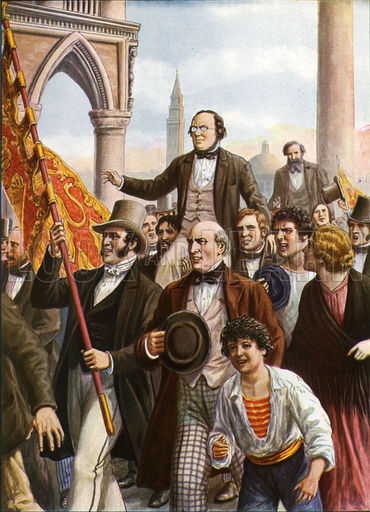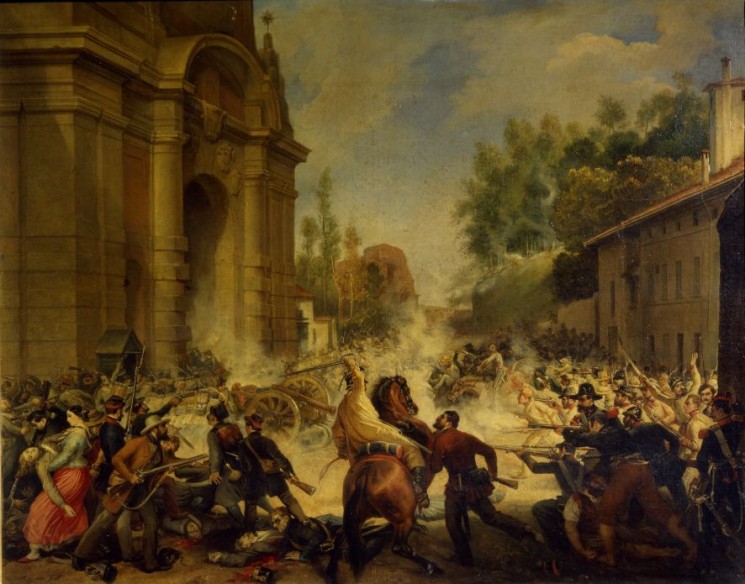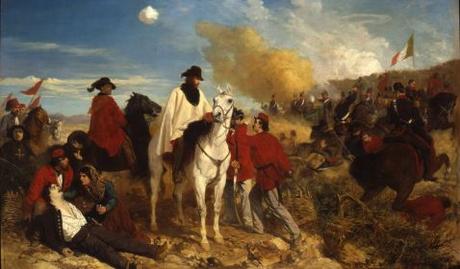Revolutions of 1848 in the Italian states on:
[Wikipedia]
[Google]
[Amazon]
The 1848 Revolutions in the Italian states, part of the wider

 After witnessing the liberal friendly events that were occurring in Rome, the people of other states started to demand similar treatment. It commenced on 12 January in Sicily, where the people began to demand a Provisional Government, separate from the government of the mainland. King Ferdinand II tried to resist these changes, however a full-fledged revolt erupted in Sicily, a revolt also erupted in Salerno and Naples. These revolts drove Ferdinand and his men out of Sicily, and forced him to allow a provisional government to be constituted.
Notwithstanding the events in Rome and Naples, the states still were under a conservative rule. Italians in Lombardo-Veneto could not enjoy these freedoms. The Austrian Empire of this region had tightened their grip on the people by further oppressing them with harsher taxes. Tax gatherers were sent out along with the 100,000 man army standing in place, and letting their presence be known.
After witnessing the liberal friendly events that were occurring in Rome, the people of other states started to demand similar treatment. It commenced on 12 January in Sicily, where the people began to demand a Provisional Government, separate from the government of the mainland. King Ferdinand II tried to resist these changes, however a full-fledged revolt erupted in Sicily, a revolt also erupted in Salerno and Naples. These revolts drove Ferdinand and his men out of Sicily, and forced him to allow a provisional government to be constituted.
Notwithstanding the events in Rome and Naples, the states still were under a conservative rule. Italians in Lombardo-Veneto could not enjoy these freedoms. The Austrian Empire of this region had tightened their grip on the people by further oppressing them with harsher taxes. Tax gatherers were sent out along with the 100,000 man army standing in place, and letting their presence be known.
 These revolts in Sicily helped to spark revolts in the northern
These revolts in Sicily helped to spark revolts in the northern
 Despite the fact that Pius had abandoned the war against the Austrians, many of his people had still fought alongside Charles Albert. The people of Rome rebelled against Pius' government and assassinated Pellegrino Rossi, Pius' minister. Pope Pius IX then fled to the fortress of Gaeta, under the protection of King Ferdinand II. In February 1849, he was joined by Leopold II, Grand Duke of Tuscany who had to flee from there because of another insurrection. Piedmont was also lost to the Austrians in 1849 and Charles Albert had to abdicate leaving his son, Victor Emanuel II, to rule.
In Rome, the authority that did take over passed popular legislation to eliminate burdensome taxes and give work to the unemployed. Giuseppe Garibaldi and
Despite the fact that Pius had abandoned the war against the Austrians, many of his people had still fought alongside Charles Albert. The people of Rome rebelled against Pius' government and assassinated Pellegrino Rossi, Pius' minister. Pope Pius IX then fled to the fortress of Gaeta, under the protection of King Ferdinand II. In February 1849, he was joined by Leopold II, Grand Duke of Tuscany who had to flee from there because of another insurrection. Piedmont was also lost to the Austrians in 1849 and Charles Albert had to abdicate leaving his son, Victor Emanuel II, to rule.
In Rome, the authority that did take over passed popular legislation to eliminate burdensome taxes and give work to the unemployed. Giuseppe Garibaldi and
in JSTOR
* Ginsborg, Paul. ''Daniele Manin and the Venetian Revolution of 1848-49'' (1979) * Rapport, Michael. ''1848: Year of Revolution'' (2010) pp 79–93 * Robertson, Priscilla. ''Revolutions of 1848: A Social History'' (1952) pp 311–401 * Smith, Denis Mack. ''Mazzini'' (1996)
excerpt and text search
h1>
Revolutions of 1848 {{DEFAULTSORT:Revolutions Of 1848 In The Italian States
Revolutions of 1848
The Revolutions of 1848, known in some countries as the Springtime of the Peoples or the Springtime of Nations, were a series of political upheavals throughout Europe starting in 1848. It remains the most widespread revolutionary wave in Europea ...
in Europe, were organized revolts in the states of the Italian peninsula and Sicily
(man) it, Siciliana (woman)
, population_note =
, population_blank1_title =
, population_blank1 =
, demographics_type1 = Ethnicity
, demographics1_footnotes =
, demographi ...
, led by intellectuals and agitators who desired a liberal government. As Italian nationalists they sought to eliminate reactionary Austrian control. During this time, Italy was not a unified country, and was divided into many states, which, in Northern Italy, were ruled by the Austrian Empire
The Austrian Empire (german: link=no, Kaiserthum Oesterreich, modern spelling , ) was a Central-Eastern European multinational great power from 1804 to 1867, created by proclamation out of the realms of the Habsburgs. During its existence ...
. A desire to be independent from foreign rule, and the conservative leadership of the Austrians, led Italian revolutionaries to stage revolution in order to drive out the Austrians. The revolution was led by the state of the Kingdom of Sardinia
The Kingdom of Sardinia,The name of the state was originally Latin: , or when the kingdom was still considered to include Corsica. In Italian it is , in French , in Sardinian , and in Piedmontese . also referred to as the Kingdom of Savoy-S ...
. Some uprisings in the Kingdom of Lombardy–Venetia
The Kingdom of Lombardy–Venetia ( la, links=no, Regnum Langobardiae et Venetiae), commonly called the "Lombardo-Venetian Kingdom" ( it, links=no, Regno Lombardo-Veneto, german: links=no, Königreich Lombardo-Venetien), was a constituent land ...
, particularly in Milan
Milan ( , , Lombard: ; it, Milano ) is a city in northern Italy, capital of Lombardy, and the second-most populous city proper in Italy after Rome. The city proper has a population of about 1.4 million, while its metropolitan city h ...
, forced the Austrian General Radetzky to retreat to the Quadrilatero (Quadrilateral) fortresses.
King Charles Albert
Charles Albert (; 2 October 1798 – 28 July 1849) was the King of Sardinia from 27 April 1831 until 23 March 1849. His name is bound up with the first Italian constitution, the Albertine Statute, and with the First Italian War of Independenc ...
, who ruled Piedmont-Sardinia from 1831 to 1849, aspired to unite Italy with the endorsement of Pope Pius IX, head of the Papal States, which comprised then vast territories in the center of the Italian peninsula. He declared war on Austria in March 1848 and launched a full-out attack on the Quadrilateral. Lacking allies, Charles Albert was no match for the Austrian army and was defeated at the Battle of Custoza on 24 July 1848. He signed a truce and withdrew his forces from Lombardy, and thus Austria remained dominant in a divided Italy until the Second Italian War of Independence
The Second Italian War of Independence, also called the Franco-Austrian War, the Austro-Sardinian War or Italian War of 1859 ( it, Seconda guerra d'indipendenza italiana; french: Campagne d'Italie), was fought by the Second French Empire and t ...
.
The rebellion
 After witnessing the liberal friendly events that were occurring in Rome, the people of other states started to demand similar treatment. It commenced on 12 January in Sicily, where the people began to demand a Provisional Government, separate from the government of the mainland. King Ferdinand II tried to resist these changes, however a full-fledged revolt erupted in Sicily, a revolt also erupted in Salerno and Naples. These revolts drove Ferdinand and his men out of Sicily, and forced him to allow a provisional government to be constituted.
Notwithstanding the events in Rome and Naples, the states still were under a conservative rule. Italians in Lombardo-Veneto could not enjoy these freedoms. The Austrian Empire of this region had tightened their grip on the people by further oppressing them with harsher taxes. Tax gatherers were sent out along with the 100,000 man army standing in place, and letting their presence be known.
After witnessing the liberal friendly events that were occurring in Rome, the people of other states started to demand similar treatment. It commenced on 12 January in Sicily, where the people began to demand a Provisional Government, separate from the government of the mainland. King Ferdinand II tried to resist these changes, however a full-fledged revolt erupted in Sicily, a revolt also erupted in Salerno and Naples. These revolts drove Ferdinand and his men out of Sicily, and forced him to allow a provisional government to be constituted.
Notwithstanding the events in Rome and Naples, the states still were under a conservative rule. Italians in Lombardo-Veneto could not enjoy these freedoms. The Austrian Empire of this region had tightened their grip on the people by further oppressing them with harsher taxes. Tax gatherers were sent out along with the 100,000 man army standing in place, and letting their presence be known.
 These revolts in Sicily helped to spark revolts in the northern
These revolts in Sicily helped to spark revolts in the northern Kingdom of Lombardy–Venetia
The Kingdom of Lombardy–Venetia ( la, links=no, Regnum Langobardiae et Venetiae), commonly called the "Lombardo-Venetian Kingdom" ( it, links=no, Regno Lombardo-Veneto, german: links=no, Königreich Lombardo-Venetien), was a constituent land ...
. Revolutions in the Lombardy city of Milan
Milan ( , , Lombard: ; it, Milano ) is a city in northern Italy, capital of Lombardy, and the second-most populous city proper in Italy after Rome. The city proper has a population of about 1.4 million, while its metropolitan city h ...
forced about 20,000 of an Austrian General Radetsky's troops to withdraw from the city. Eventually General Radetsky was forced to completely withdraw his troops from the two states, however, due to his expertise, he was able to keep the Quadrilateral fortresses of Verona
Verona ( , ; vec, Verona or ) is a city on the Adige River in Veneto, Italy, with 258,031 inhabitants. It is one of the seven provincial capitals of the region. It is the largest city municipality in the region and the second largest in nor ...
, Peschiera, Legnano and Mantua
Mantua ( ; it, Mantova ; Lombard and la, Mantua) is a city and '' comune'' in Lombardy, Italy, and capital of the province of the same name.
In 2016, Mantua was designated as the Italian Capital of Culture. In 2017, it was named as the Eur ...
. Through his skillful tactics he brought his men that had been withdrawn into the key forts. Meanwhile, the Italian insurgents were encouraged when news of Prince Metternich abdicating in Vienna spread out, but were unable to completely eradicate Radetsky's troops. Also, by this time Charles Albert of Piedmont had published a liberal constitution for Piedmont.
In the Quadrilateral General Radetsky and his men were plotting a counterattack in order to regain their lost ground. However, they were interrupted by Charles Albert of Sardinia, the King of Sardinia, who had by then taken the forefront of the attack, and had launched an attack against the Quadrilateral. Charles charged the fortress from all sides aided by 25,000 reinforcements, who came in assistance of their fellow citizens. While journeying to the fortress preparing for the attack, Charles garnered the support of princes of other states. His fellow princes responded by sending reinforcements to his aid: Leopold II, Grand Duke of Tuscany sent 8,000, Pope Pius contributed 10,000, and Ferdinand II sent 16,050 men on the advice of general Guglielmo Pepe. They attacked the fortresses and on 3 May 1848 succeeded in winning the battle of Goito
The Battle of Goito was fought between the Piedmontese and the Austrian army on 30 May 1848, in the course of the First Italian War of Independence. The Piedmontese army won the battle, as the Austrians were unable to break through to relieve the ...
and capturing the fortress of Peschiera.
At that point, Pope Pius IX became nervous about defeating the Austrian empire and withdrew his troops, citing that he could not endorse a war between two Catholic nations. King Ferdinand of the Kingdom of the Two Sicilies also called his soldiers back and retired his troops. However, some of them did not comply with the order and continued on under the guidance of Generals Pepe, Durando and Giovanni. A year later, Charles launched another attack, but, due to the lack of troops, he was defeated in the Battle of Novara.
Aftermath
 Despite the fact that Pius had abandoned the war against the Austrians, many of his people had still fought alongside Charles Albert. The people of Rome rebelled against Pius' government and assassinated Pellegrino Rossi, Pius' minister. Pope Pius IX then fled to the fortress of Gaeta, under the protection of King Ferdinand II. In February 1849, he was joined by Leopold II, Grand Duke of Tuscany who had to flee from there because of another insurrection. Piedmont was also lost to the Austrians in 1849 and Charles Albert had to abdicate leaving his son, Victor Emanuel II, to rule.
In Rome, the authority that did take over passed popular legislation to eliminate burdensome taxes and give work to the unemployed. Giuseppe Garibaldi and
Despite the fact that Pius had abandoned the war against the Austrians, many of his people had still fought alongside Charles Albert. The people of Rome rebelled against Pius' government and assassinated Pellegrino Rossi, Pius' minister. Pope Pius IX then fled to the fortress of Gaeta, under the protection of King Ferdinand II. In February 1849, he was joined by Leopold II, Grand Duke of Tuscany who had to flee from there because of another insurrection. Piedmont was also lost to the Austrians in 1849 and Charles Albert had to abdicate leaving his son, Victor Emanuel II, to rule.
In Rome, the authority that did take over passed popular legislation to eliminate burdensome taxes and give work to the unemployed. Giuseppe Garibaldi and Giuseppe Mazzini
Giuseppe Mazzini (, , ; 22 June 1805 – 10 March 1872) was an Italian politician, journalist, and activist for the unification of Italy (Risorgimento) and spearhead of the Italian revolutionary movement. His efforts helped bring about the in ...
came to build a ''"Rome of the People,"'' and the short-lived ''Roman Republic
The Roman Republic ( la, Res publica Romana ) was a form of government of Rome and the era of the classical Roman civilization when it was run through public representation of the Roman people. Beginning with the overthrow of the Roman Ki ...
'' was proclaimed. The Republic succeeded in inspiring the people to build an independent Italian nation. It also attempted to improve economically the lives of the underserved by giving some of the Church's large landholdings to poor peasants. It also made prison and insane asylum reforms, gave freedom to the press, provided secular education, but shied away from the "Right to Work
The right to work is the concept that people have a human right to work, or engage in productive employment, and should not be prevented from doing so. The right to work is enshrined in the Universal Declaration of Human Rights and recognized ...
", having seen this fail in France.
However, the many reforms instituted by the new Republic combined with its lowering of taxes brought about monetary problems which the Republic then compounded by simply printing more money.Rafaeli de Cesare, Last Days of Papal Rome 1850-1870, Houghton Mifflin, 1909, p. 28. Runaway price inflation doomed the economy of the Republic. In addition sending troops to defend the Piedmont from Austrian forces put Rome at risk of attack from Austria. However, Pope Pius appealed to Napoleon III
Napoleon III (Charles Louis Napoléon Bonaparte; 20 April 18089 January 1873) was the first President of France (as Louis-Napoléon Bonaparte) from 1848 to 1852 and the last monarch of France as Emperor of the French from 1852 to 1870. A nephew ...
for help. The French President saw this as an opportunity to gain Catholic support. The French army arrived by sea under the command of general Charles Oudinot, and, despite an early loss to Garibaldi, the French, with the help of the Austrians, eventually defeated the Roman Republic. On July 12, 1849 Pope Pius IX was escorted back into town and ruled under French protection until 1870.
See also
*Revolutions of 1848
The Revolutions of 1848, known in some countries as the Springtime of the Peoples or the Springtime of Nations, were a series of political upheavals throughout Europe starting in 1848. It remains the most widespread revolutionary wave in Europea ...
* Revolt of Genoa
*Unification of Italy
The unification of Italy ( it, Unità d'Italia ), also known as the ''Risorgimento'' (, ; ), was the 19th-century political and social movement that resulted in the consolidation of different states of the Italian Peninsula into a single ...
References
Further reading
* De Mattei, Roberto. ''Pius IX'' (2004) * Ginsborg, Paul. "Peasants and Revolutionaries in Venice and the Veneto, 1848," ''Historical Journal,'' Sep 1974, Vol. 17 Issue 3, pp 503–55in JSTOR
* Ginsborg, Paul. ''Daniele Manin and the Venetian Revolution of 1848-49'' (1979) * Rapport, Michael. ''1848: Year of Revolution'' (2010) pp 79–93 * Robertson, Priscilla. ''Revolutions of 1848: A Social History'' (1952) pp 311–401 * Smith, Denis Mack. ''Mazzini'' (1996)
excerpt and text search
h1>
External links
Revolutions of 1848 {{DEFAULTSORT:Revolutions Of 1848 In The Italian States